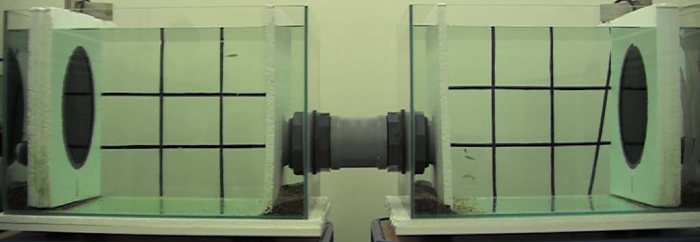Research project
Zebrafish personality, stress physiology and behaviour in the context of sound exposure
To what extent is sound a stressor to fish? And are behavioural and physiological phenotypes equally sensitive to disturbance by noise pollution?
- Duration
- 2012 - 2020
- Contact
- Hans Slabbekoorn
- Funding
-
 Institute of Biology Leiden (IBL)
Institute of Biology Leiden (IBL)

We study behavioural phenotypes in zebrafish and explore the acoustic world of aquarium fish. Studies into consistent individual variation in larvae and adults can reveal important insights into behavioural patterns of this domesticated fish species that has become an important model species in medical and pharmaceutical research. Behaviour and physiology also provide insight into fish wellbeing and potential long-term consequences. As noise pollution is a growing concern in natural waters, aquacultural facilities and hobby and research aquaria, we use zebrafish to explore the effects of artificial sound fields in small tanks on their feeding and swimming behaviour, diurnal rhythms and stress physiology.
The behaviour of zebrafish in a fish tank can tell much about their well-being. Active swimming, throughout the tank, while searching, finding and ingesting food is typically interpreted as reflecting fish that feel comfortable and relaxed. When they are disturbed or affected by an external stressor, zebrafish stay down, close to tank walls and close together. Swimming speed can go up or completely down, when a highly disturbing factor makes them freeze. Standardized behavioural essays and advanced methods for quantification are used to assess variation among individuals and context-dependent effects.
Individual zebrafish can be bold or shy, or anything in between. This means that fish differ behaviourally and that they have individual features that are consistent across time and context. We also found out that there are fish that have clear fluctuations in activity over the day driven by their internal clock, while others have less stereotypic patterns. More active fish are more active in the morning, while less active ones spread their activities over the day, reminiscent of so-called ‘larks’ and ‘owls’ in humans. We study the link between the variation in rhythmicity and the link with sensitivity to environmental stressors such as noise pollution.
Environmental stressors cause a rise in the level of the stress hormone cortisol. The base line level reaches a peak after about 15 minutes to recover again after the disturbance. The bold or proactive fish recover relatively fast, while the shy or reactive fish take much longer. Fluctuations in cortisol are dynamic changes that are functional and aid the individual to respond best to conditions of the outside world. However, repeated events may also yield chronic elevations in cortisol level that become detrimental to the animal’s health. We study whether and under what conditions sound may have negative effects.

Experimental aquarium set-up in which a group of zebrafish can swim in two tanks connected by a swimming tube and in which the sound conditions can be manipulated independently through underwater speakers.
- Amin, B., Slabbekoorn, H., Schaaf, M. & Tudorache, C. (2016). "Early birds" take it easy: diurnal timing is correlated with overall level in activity of zebrafish larvae. Behaviour 153: 1745-1762
- Neo, Y.Y., Parie, L., Bakker, F., Snelderwaard, P., Tudorache, C., Schaaf, M. & Slabbekoorn, H. 2015. Behavioral changes in response to sound exposure and no spatial avoidance of noisy conditions in captive zebrafish. Frontiers in Behavioural Neurosciences 9: 1–11
- Shafiei Sabet, S., van Dooren, D. & Slabbekoorn, H. 2016. Son et lumière: sound and light effects on spatial distribution and swimming behavior in captive zebrafish. Environmental Pollution 214: 26-34
- Shafiei Sabet, S., Wesdorp, K., Campbell, J. & Slabbekoorn, H. 2015. Behavioural responses to sound exposure in captivity by two fish species with different hearing ability. Animal Behaviour 116: 1-11
- Shafiei Sabet, S., Neo, Y.Y. & Slabbekoorn, H. 2015. The effect of temporal variation in experimental noise exposure on swimming and foraging behaviour of captive zebrafish. Animal Behaviour 109: 49–60
- Tudorache, C., Schaaf, M. J. M., & Slabbekoorn, H. 2013. Covariation between behaviour and physiology indicators of coping style in zebrafish (Danio rerio). The Journal of Endocrinology 219: 251–8
- Tudorache, C., Ter Braake, A., Tromp, M., Slabbekoorn, H., & Schaaf, M. J. M. 2015. Behavioral and physiological indicators of stress coping styles in larval zebrafish. Stress 18: 1025–3890
